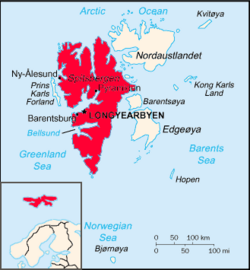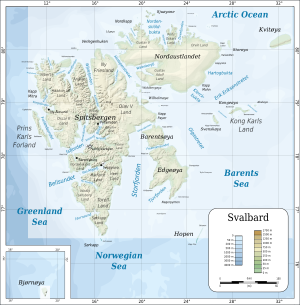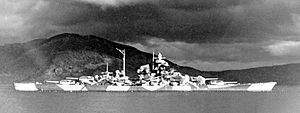Operation Zitronella facts for kids
Quick facts for kids Operation Zitronella |
|||||||
|---|---|---|---|---|---|---|---|
| Part of World War II | |||||||
 Map of Svalbard with Spitsbergen in the west emphasised |
|||||||
|
|||||||
| Belligerents | |||||||
| Commanders and leaders | |||||||
| Strength | |||||||
| 2 battleships 9 destroyers 1 battalion fortress infantry |
152 soldiers 2 coastal guns 2 AA guns |
||||||
| Casualties and losses | |||||||
| 1 died of wounds 15 wounded |
6 killed 31 (POW) |
||||||
Operation Zitronella (which means "Operation Lemon Flavour" in German) was a big attack by German forces on the island of Spitsbergen in Svalbard, Norway. It happened on September 8, 1943, during World War II.
Two powerful German battleships, the Tirpitz and the Scharnhorst, along with nine destroyers, sailed to the islands. They bombed areas controlled by the Allies in Isfjorden and helped land German soldiers. Six Norwegian soldiers were killed, and 31 were captured. Sixteen German soldiers were hurt, and one later died from his injuries. This was the only time the battleship Tirpitz was used in an attack.
Contents
Why Svalbard Was Important
The Arctic Islands
The Svalbard islands are in the Arctic Ocean, about 650 miles (1,050 km) from the North Pole. They are also about the same distance from Norway. The islands are very mountainous, with snowy peaks and glaciers. In winter, everything is covered in snow, and the bays freeze over.
The western part of Svalbard, called Spitsbergen Island, has many large fjords (long, narrow inlets of the sea). Isfjorden is one of these, and it can be up to 10 miles (16 km) wide. The Gulf Stream makes the water warmer, so the sea is free of ice during the summer.
In the 1940s, there were towns like Longyearbyen and Barentsburg on Spitsbergen. People from many countries settled there. A treaty signed in 1920 made the islands neutral, meaning no country owned them fully. It also gave different countries rights to mine for minerals and fish. Before 1939, about 3,000 people lived there, mostly Norwegian and Soviet workers who mined coal.
Svalbard in World War II
During World War II, Svalbard became important for military operations. In August 1941, British, Canadian, and Free Norwegian Forces landed on Spitsbergen. This was part of an operation called Operation Gauntlet. Their goal was to destroy the coal mines and equipment so the Germans couldn't use them. The people living there were moved to safety.
Nazi Germany also wanted to use the Arctic. They set up weather stations to get better weather forecasts. These forecasts were very important for their ships and submarines fighting against Allied convoys (groups of ships) traveling from the UK to the USSR.
One German weather station, called Bansö, was set up in Advent Bay. The British knew about these stations because they were able to secretly read German messages. British ships went to investigate, and the Germans had to leave their station quickly. But they returned once the British ships were gone.
Later, in April 1942, Norwegian forces tried to take control of the islands again in Operation Fritham. This operation had problems, but by the summer of 1943, the Allies, through Operation Gearbox and Operation Gearbox II, had secured control of the islands. This meant the Norwegians were back in charge.
Planning the Attack
The German navy, called the Kriegsmarine, decided to remove their weather station from Svalbard in the summer of 1942. This was because the ice melted, making it easier for Allied forces to attack the station. A German submarine, the U-435, safely picked up the six men from the station.
In 1943, the leader of the German navy, Karl Dönitz, wanted to show how valuable his big warships were. He planned to use them in an attack to boost the morale of his sailors.
The German Plan
The plan for Operation Zitronella involved the battleships Tirpitz and Scharnhorst, along with nine destroyers. They also carried a battalion (a group of soldiers) of fortress infantry. The ships left for Svalbard on September 6.
The German fleet sailed carefully, with destroyers protecting the battleships from submarines. On September 7, they received a message that a British plane had flown over their starting point. This meant the British might know they were gone, but the German ships were already halfway to Svalbard.
The Attack Begins
At 3:00 a.m. on September 8, the Scharnhorst and some destroyers landed troops in Advent Bay. Meanwhile, the Tirpitz and other destroyers sailed to Barentsburg. The Tirpitz even flew a white flag, like a trick, to surprise the defenders.
Just before the German ships started firing, they intercepted a radio message from the Norwegians. It said that three Allied cruisers and seven destroyers had arrived. The Tirpitz tried to block the message, but it seemed the message had been sent. The Tirpitz then fired its big guns to silence the Norwegian radio transmitter.
Around 4:00 a.m., the battleships began their attack. The Tirpitz fired its huge 15-inch guns at Barentsburg, and the Scharnhorst fired its 11-inch guns at Longyearbyen. The Norwegians only had two small 3-inch guns to defend themselves. The German destroyers landed their soldiers. The Norwegian guns were quickly destroyed, and the Germans destroyed coal piles, food supplies, and power generators.
Some German destroyers were damaged by Norwegian Bofors guns. The Tirpitz then fired its main guns, silencing the Bofors guns and setting a coal mine on fire. By 5:00 a.m., the German soldiers had landed as planned.
The Norwegian survivors ran into the hills. The German landing party took over the buildings in Barentsburg. The German commander wanted his soldiers back on the ships by 11:00 a.m. because he was worried about the radio message the Norwegians had sent.
By 5:12 a.m., the Scharnhorst reported that the Norwegians in Longyearbyen had been defeated. By 8:00 a.m., the German commander reported that all the demolitions (destroying things) were finished. After bombing the area, the German ships picked up their soldiers and the prisoners by 11:00 a.m. The Tirpitz fired a few more shells at ammunition and fuel dumps outside Barentsburg. The German ships then left at 19 knots (35 km/h).
The Norwegians managed to fix their radio and send a report about the German attack. This made the British Home Fleet sail from Scotland, but it was too late to catch the German ships, which arrived back in port on September 9.
After the Battle
Casualties
Sixteen German sailors were wounded, and one of them later died. Six Norwegian soldiers were killed. Captain Morten Bredsdorff and 30 other Norwegian prisoners were sent to a prisoner-of-war camp in Poland.
Later Events
After the attack, the German air force (Luftwaffe) secretly set up another weather station on Hopen Island. The airmen there were isolated for months after Germany surrendered in May 1945. They finally gave themselves up to a Norwegian fishing boat in September 1945.
A British-Soviet attack on the Tirpitz and Scharnhorst was being planned when the ships sailed for Svalbard. A British reconnaissance plane was sent to check Isfjorden. The plane flew over Svalbard, taking photos and finding only destroyed buildings and smoke from the fires started by the Germans. The plane then flew towards Norway, looking for the German ships, but didn't find them. This flight was part of Operation Source, a plan to attack the German battleships using special midget submarines.
See also




